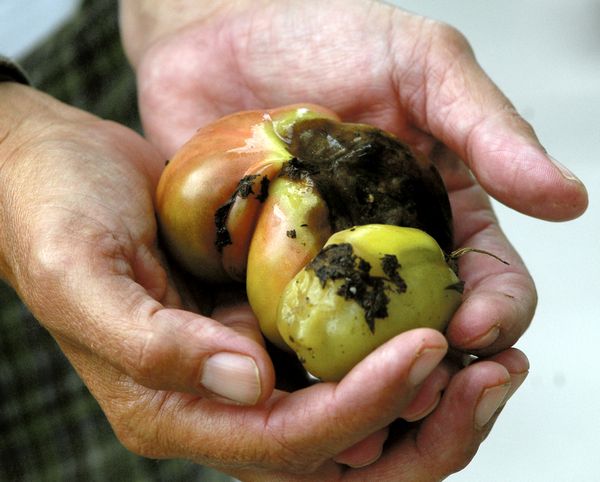Subscriptions
Menu
Advertisements
Oh no! The blight!
8/25/2009 |
By Jim Poole and Patsy Nicosia |

Although they probably didn’t know it at the time, a cool, wet June spelled doom for many backyard gardeners.
That weather provided perfect conditions for late blight, which destroyed backyard tomatoes and potatoes, though commercial growers are surviving pretty well. (See related story.)
Late blight is a fungus––the same that caused the Irish Potato Famine––that turns leaves to gray, then black, and causes mushy bruise-like marks on young fruit.
And then the plants die.
Late blight arrived in the area on young plants from the South that were sold in big box stores, according to Crystal Stewart of the Capital District Fruit and Vegetable Program.
“In a normal year, we probably would have gotten through it okay,” Ms. Stewart said. “But the weather conditions were perfect for it this year.”
Borne through the air, the fungus spores traveled from the infected plants to “everywhere. It’s literally everywhere,” Ms. Stewart said.
Once it’s in a garden, late blight is difficult if not impossible to stop, she added.
Copper fungicide will retard late blight’s growth but won’t cure the plant.
“I know some gardeners will hand pick the infected leaves and then spray the rest, but that’s pretty impractical for most people,” Ms. Stewart said.
The trick is to start spraying before late blight gets started, which is what many commercial growers did.
Dave Laraway, the Northeast Gardener on WSDE, has a highly productive backyard garden. Like the commercial farmers, he sprayed early, too, using a copper product.
“It’s like the flu,” Mr. Laraway said. “If you’ve already got the flu, a flu shot won’t help you.”
A veteran gardener, Mr. Laraway sprays every year just as a precaution, because the copper fungicide––an organic product––takes care of the more common powdery mildew, too.
Spraying means spraying again and again, after every substantial rain, so the cost mounts, but it also results in saving the plants.
If tomatoes began to ripen before being hit by the blight, they may fully ripen. They’re edible, Ms. Stewart said; just cut away the infected portion.
Potatoes are edible, too, for while the plants die above the ground, the tubers underground will continue to grow, she said.
“There’s a lot of misinformation out there,” Ms. Stewart said. “The tomatoes are not toxic, but sometimes late blight makes them pretty unappealing.”
But because the same wet and cool weather that fostered late blight also slowed tomato growth, most backyard gardeners won’t get any tomatoes at all.
That’s not the same crisis as a farmer losing his entire crop, but it’s a minor disaster for some.
“A lot of people are depending on that food,” said David Cox of Cornell Cooperative Extension in Schoharie County.
“And there’s really nothing to do. It’s just all-encompassing.”
Mr. Cox did point out the one positive that this is a learning experience. Gardeners will be better prepared if we get a similar weather pattern next June.
So what about next year?
Late blight on tomatoes won’t winter over because the spores need live plant matter to survive. Our winters are too severe for them to live, Ms. Stewart said.
Still, she added, it’s good garden practice to clean up. Infected plants and all the fallen fruit and leaves should be bagged and put out with the trash.
Late-blighted potatoes require more clean-up. Like tomatoes, all plants should be bagged and trashed.
Also, tubers must be dug up and discarded because they will winter over, providing sustenance for late blight to winter over, also, Ms. Stewart said.
Under no circumstances, she added, should the infected plants be composted.
Mr. Laraway agreed.
“And don’t burn the plants,” he added. “Some people think they’re getting rid of it when they burn, but they’re only releasing the spores into the air to infect someone else’s garden.”









